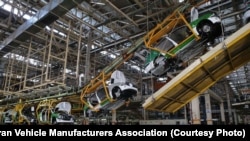The 21st National Conference on Industry and Mines took place on July 8, attended by First Deputy President Eshaq Jahangiri and Industry, Mining, and Trade Minister Mohammad Reza Nematzadeh to assess Iran’s industrial performance and how to improve it, writes Radio Farda economy analyst Ahmad Alavi.
“If we want to become a country that has a say [in international affairs] and enjoys an influential position in the world, we should increase our soft power, which means progress and development, particularly in the industrial sector,” Jahangiri said.
However, the fundamental questions are how Iran’s industry ranks in relation to other countries in the region and whether it is capable of addressing problems like unemployment.
A new report compiled by the Industry, Mining, and Trade Ministry reviewing international indices and statistics highlights Iran’s position in the world, as well as in the Middle East and North Africa (MENA).
The report, titled Competitive Industrial Performance Index, says Iran’s industrial ranking in the region fluctuated between 2010 and 2014 but ultimately ended in a lower position than before.
Germany ranked first followed by Japan, the United States, and South Korea, respectively.
In the regional ranking, Iran -- despite modern industry having been introduced in Iran far earlier than other countries in the region -- ended in 10th place out of 22, which is below average.
Israel, Turkey, Saudi Arabia, the United Arab Emirates, and Bahrain sat at the top of the table, respectively.
Meanwhile, according to World Bank reports, Iran holds no apropos position when it comes to the international Economic Complexity Index.
While Iran, compared with other developing countries, enjoys an apt standing in basic education and infrastructure related to information technology and communication, it has been deprived of the means to apply its experimental knowledge on innovation and producing advanced merchandise, which are necessary for a share on world markets.
In recent years, particularly under international sanctions against Tehran, the volume of investment in Iran’s industrial sector showed a significant drop.
It is not yet clear whether Iran’s industry will recover from the downfall, even in a post-JCPOA (Joint Comprehensive Plan of Action) era where sanctions have been lifted. Iran is domestically unable to raise the necessary capital, and it needs billions of dollars in investment to update its industry.
However, foreign investments in Iran’s industrial sector have their own risks and specific complications.
Any country’s ability for industrial competition is tied to constant modernizing efforts of its private and public sectors as well as its efficiency in managerial jobs and implementing sound policies. That’s where Iran’s industrial sector is lagging and needs a thorough reform.
But, so far, steps toward reform face strong resistance.
Iran has not yet been able to eliminate detrimental economic rents and favoritism and is unable to implement a well-calculated plan to renovate and update its infrastructure.
One of the main hurdles in reforming the industrial sector in Iran, according to Economic Affairs and Finance Minister Ali Tayebnia, is government-owned companies.
“The definition of a government-owned company is a source of producing economic rents, traveling abroad, having a seat on boards, corruption, astronomical salaries, and employing as many people as you like,” he said. “That’s why 5,000 personnel are employed at a government-owned company that needs no more than 1,000. Most of these redundant positions are created to appease the friends and relatives of managers.”
Over the past four decades, many countries -- including South Korea and even Turkey -- have succeeded in the patent registration of hundreds of mercantile and industrial brands or trademarks. All of these patents depict the capability of their countries of origin for competing in international markets.
Sadly, Iran cannot compete in such an environment.
In today’s world and with the emergence of information technology, being capable of competing on international markets is the final word. Without achieving that capability, a country has no chance to enter the highly competitive arena of global trade.
Based on experience, private and small firms are in a better position to develop a country’s industrial sector than giant and bloated government companies. In most countries, 90 percent of companies are small and privately owned firms.
As a rule, small and private firms do not need huge investments, and their principle capital is their own innovation and flexibility against risks, as well as their managers’ merit and capability. In Iran’s industrial sector, these small firms and their entrepreneurial managers are noticeably absent.
This is particularly even more saddening considering that in 2016, Iran had an estimated gross domestic product of $412.2 billion, making it the second-largest economy in MENA, immediately after oil-rich Saudi Arabia. But a significant portion of that is oil-based.









